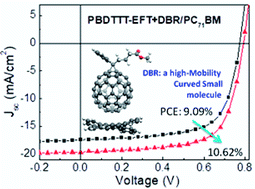Efficiency enhancement of organic photovoltaics by introducing high-mobility curved small-molecule semiconductors as additives†
Abstract
Owing to their unique molecular geometry and packing modes in the solid state, curved organic semiconductor molecules such as hexabenzoperylenes and dibenzo[a,m]rubicene exhibit high hole mobilities of ∼1 cm2 V−1 s−1, which are much higher than the hole mobilities of the active layers in organic photovoltaics (OPVs). The efficiencies of OPVs based on a fullerene acceptor are relatively improved by over 20% by introducing high-mobility curved p-type organic semiconductors into the active layers as additives in only a few weight percentage. This can be attributed to the increased hole mobilities in the devices. In comparison, the significant efficiency enhancement cannot be observed when high-mobility planar molecules are introduced into the active layers. In view of the curved p-type semiconductors being more compatible with a fullerene acceptor in their molecular shape than a planar one, we consider that the intimate interaction between the curved molecule and the fullerene acceptor can enhance exciton dissociation and hole transfer and thus boost the power conversion efficiencies of the devices.



 Please wait while we load your content...
Please wait while we load your content...